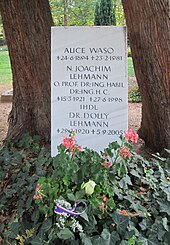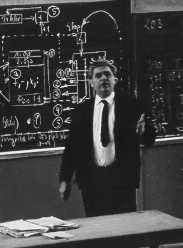Nikolaus Joachim Lehmann
Nikolaus Joachim Lehmann ( Upper Sorbian Mikławš Joachim Wićaz ; born March 15, 1921 in Camina ; † June 27, 1998 in Dresden ), usually just called NJ Lehmann for short , was one of the most important computer scientists in the GDR . He is also known for achievements in numerical mathematics .
Life

Lehmann was born in Camina in 1921 as the son of a construction technician and sawmill owner and a seamstress. From 1927 to 1931 he attended elementary school in Radibor . The father died in 1933. After passing his Abitur in 1939, Lehmann did the Reich Labor Service in Seifhennersdorf .
From 1940 to 1945 he completed mathematics and physics studies at the TH Dresden , among others under Friedrich Adolf Willers and Heinrich Barkhausen . After the end of the war, he completed his second diploma thesis in 1946, because the documents for his first work were destroyed in the bombing raids on Dresden . In 1948 he received his doctorate in engineering. with distinction. In 1952 Lehmann was appointed lecturer at the TH Dresden, and a year later professor for applied mathematics . Between 1956 and 1968 Lehmann was director of the new institute for computer technology in Dresden, then until his retirement in 1986 head of the department of mathematical cybernetics and computer technology .
Lehmann died in 1998 and was buried in the Striesen cemetery .
Act
In numerical mathematics he worked on boundary value problems and integral equations , error bounds for approximate solutions of differential equations and optimal bounds for linear eigenvalue problems . The Lehmann-Maehly method is named after him (also after Hans Jakob Mähly ) and the Lehmann-Goerisch method (limits for eigenvalues, also after Friedrich Goerisch ).
During his time at the Technical University in Dresden, he developed various calculating machines, including the GDR's first desktop calculator . Most important are probably the computers of the Dresden series (designation D ). The D1 and D2 were still equipped with tubes and relays , the D3 and D4 were implemented in semiconductor technology. The main ones are here:
Development of the D5 stopped in 1966.
Leibniz's mechanical calculating machine was also recreated under his direction . Although this never worked correctly during Leibniz's lifetime, minor errors could be corrected, so that today a fully functional replica can be viewed in the Dresden Technical Collections . This finally provided proof that the functional principle was correct and that only manufacturing problems stood in the way of correct function.
Lehmann's estate has been in the Deutsches Museum in Munich since 1999 .
Lecture on computer technology
In 1969, computer technology was introduced as a full course in the GDR (see computer science course ).
The adjacent historical recording from 1967 shows the first lesson, the introduction to the lecture series Machine Computing Technology in the large mathematics lecture hall of the TU Dresden in the Trefftz building on Zellescher Weg.
Lehmann began the introduction with an analogy, the working method of a computing office with mechanical computing machines ( four-species machine ) for contract work. Large orders are distributed to several employees with work instructions on paper. Paper is the memory with the program control, and the intermediate results are also passed on on paper (memory).
The chalk drawing on the blackboard shows the Von Neumann architecture with
and the command execution in the individual steps 1-2-3-4-5 of the Von Neumann cycle, numbered here .
Awards and honors
- National Prize of the GDR III. Science and Technology Class - 1964
- Order of Cyril and Methodius ( Bulgaria ) - 1970
- Member and Vice-President of the IFIP General Assembly
- Great Scientist of the People - 1986
- Konrad Zuse Medal for Services to Computer Science (FRG) - 1989
- Honorary doctorate from the University of Rostock - 1989
The Lehmann Center for "Integrated Engineering" is named after him , a central scientific facility of the TU Dresden connected to the Center for Information Services and High-Performance Computing with a Petaflops computer from Bull .
Fonts
- Error bounds for approximate solutions in differential equations, Numerical Mathematics, Volume 10, 1967, pp. 261–288
- Calculation of eigenvalue bounds for linear problems, Arch. Math. (Basel), Volume 2, 1949/50, pp. 139–147
- Contributions to the numerical solution of linear eigenvalue problems, 2 parts, Zeitschrift für Angewandte Mathematik und Mechanik, Volume 29, 1949/50, pp. 341–356, Volume 30, 1949/50, pp. 1–16
- Optimal eigenvalue inclusions, Numerical Mathematics, Volume 5, 1963, pp. 246–272
literature
- Short biography for: Lehmann, Nikolaus Joachim . In: Who was who in the GDR? 5th edition. Volume 1. Ch. Links, Berlin 2010, ISBN 978-3-86153-561-4 .
Web links
- Literature by and about Nikolaus Joachim Lehmann in the catalog of the German National Library
- TUD poster about Lehmann (PDF; 2.65 MB)
- Torsten Klaus: "Who is Lehmann?" - Small computer from the GDR. In: heise Online , April 29, 2003
- Photo, lecture on computer architecture 1967 Lehmann
- Manfred Ludwig : Life and work of Professor NJ Lehmann (PDF), TU Dresden
- Karl Hantzschmann : NJ Lehmann, the Saxon computer pioneer (PDF), 2011
Individual evidence
- ↑ Central facilities: Lehmann Center ( Memento from March 26, 2015 in the Internet Archive ), TU Dresden
| personal data | |
|---|---|
| SURNAME | Lehmann, Nikolaus Joachim |
| ALTERNATIVE NAMES | Lehmann, NJ |
| BRIEF DESCRIPTION | German computer scientist and mathematician |
| DATE OF BIRTH | March 15, 1921 |
| PLACE OF BIRTH | Camina , now part of Radibor |
| DATE OF DEATH | June 27, 1998 |
| Place of death | Dresden |




